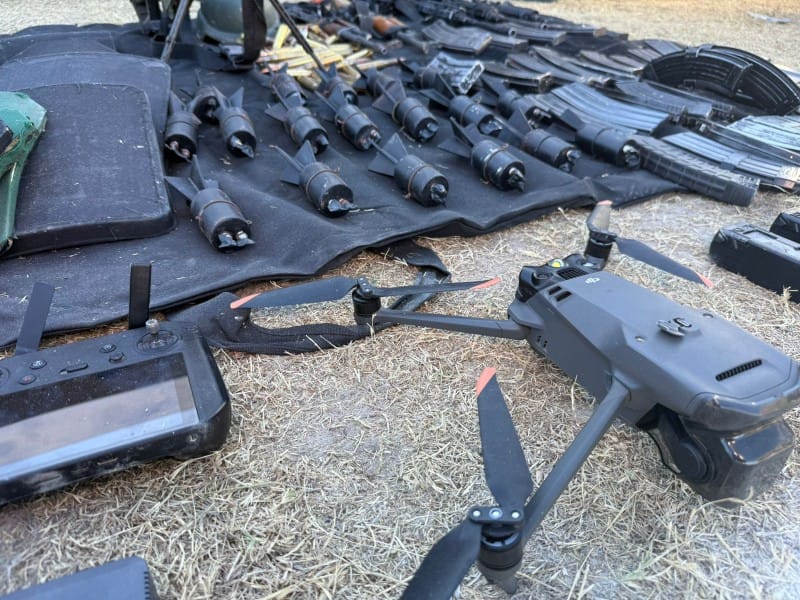The U.S. military trains obsessively for a fight that looks like Ukraine–Russia: tanks, artillery, long-range fires, and trench warfare across open plains. But just south of our border, a different kind of war is already here — and it’s escalating in phases.
This is not a hypothetical scenario. It’s an evolving operational environment in Latin America and the U.S. homeland — one where cartels, state-aligned actors, and transnational criminal networks are rapidly adopting unmanned aerial systems (UAS) and adapting them for surveillance, smuggling, and improvised munitions delivery. The tempo of change is faster than most policymakers realize — and the geography on our doorstep shapes the fight in ways that make traditional battlefield thinking obsolete.

Cartel experimentation with drones began around 2010, initially for smuggling and reconnaissance. The first recorded incident of a cartel drone carrying drugs occurred in 2015, when a DJI Phantom crashed in Tijuana with two kilos of methamphetamine.
The tempo of change is faster than most policymakers realize
From there, use cases multiplied. Drones became a standard layer in cartel operations — scouting for rival groups, tracking law enforcement, and providing live overwatch for convoys. In some regions, they became part of a 24-hour operational cycle, where shifts of pilots kept eyes in the sky over high-value routes.
What’s striking is how ordinary the hardware looked: the same commercial quadcopters used for real estate photography were now tools for securing territory, directing convoys, and avoiding checkpoints.
By 2017, Mexican criminal groups began modifying drones to carry improvised explosive devices (IEDs). At first, the designs were crude — PVC pipes and simple triggering systems. But analysis from ARMAMENT Research Services shows that by 2021–2022, these devices had evolved to mimic battlefield tactics seen in Iraq, Syria, and Ukraine.
Now, insider accounts are adding a human layer to the technical progression. In a July 2025 interview with Infobae, a former CJNG fighter — identified only as “Lima” — described how the group’s Fuerzas Especiales Mencho adapted quadcopters to drop small explosives onto vehicles and encampments. He detailed operational roles: spotters relaying coordinates, pilots flying low to avoid detection, and makeshift munitions triggered on impact. Lima characterized drone operators as having near-divine battlefield power, telling his interviewer, “I let you be God.”

Photographic timelines show changes in design, payload capacity, and reliability consistent with Lima’s description. The same adaptation pattern seen in insurgent conflicts abroad is occurring in Mexico, with tactics adjusted for the country’s terrain and cartel targets.
Seized devices in Michoacán and Guerrero have included fragmentation munitions, adapted anti-personnel charges, and even designs intended to disperse chemical irritants. The pace of refinement suggests cartels are learning not just from each other, but from foreign conflicts.
From there, use cases multiplied. Drones became a standard layer in cartel operations
The DEA and Department of Homeland Security have documented operational links between Latin American cartels and foreign non-state actors, including Hezbollah. These relationships extend beyond financing and trafficking — they include tactical knowledge transfer.
What “Lima” describes mirrors methods seen in Middle Eastern conflicts: coordinated surveillance, target marking, and precision strikes from small drones in complex terrain. While he does not claim formal foreign training, the operational similarities suggest either parallel innovation or the absorption of ideas through the same porous global channels insurgent groups have used for decades.

In Venezuela, a BRICS-aligned state with a history of harboring Hezbollah operatives, geography offers ideal terrain for covert operations: dense jungle for concealment, coastal routes for smuggling, and porous borders with Colombia and Brazil. Criminal groups and politically aligned armed actors have space to experiment with UAS just as cartels do in Mexico — and the more these methods prove effective in one arena, the faster they can be adapted elsewhere.
Venezuela, a BRICS-aligned state with a history of harboring Hezbollah operatives, offers terrain that mirrors Mexico’s in its complexity: dense jungle for concealment, coastal routes for smuggling, and porous borders with Colombia and Brazil. Armed actors can experiment with UAS in these environments, free from the constraints that govern formal militaries. Networks like these can share tested methods for defeating counter-drone systems, just as insurgent networks have done in the Middle East. A tactic proven in the Llanos of Venezuela could be in the Sierra Madre within months.
“Without rigorous testing in contested environments, the U.S. risks building an arsenal tuned to the wrong war.”
Under recent executive orders, the U.S. is accelerating domestic drone production and pushing to arm combat units with American-made systems. The intent is clear: reduce dependence on foreign manufacturers — especially Chinese firms — and bolster readiness. But a quiet question lingers: are these drones suited for the fight we’re most likely to face?
A recent U.S. Army captain told Business Insider that some of the service’s best drone pilots are drawn from video gaming backgrounds, with skills honed in virtual environments translating directly to battlefield control of unmanned systems. That pipeline is producing technically proficient operators — but it also highlights a difference in adaptation speed. While the U.S. refines formal training programs, adversaries and criminal groups often select and field operators in weeks, not months, based on immediate results rather than standardized curricula.
The Pentagon warned Congress it was unprepared for a homeland drone attack
Many procurement and demonstration models are optimized for permissive airspace and long logistical tails — conditions more like Ukraine’s battlefields than Mexico’s or Venezuela’s. In dense urban terrain, mountain valleys, or humid jungle, range and connectivity suffer. Adversaries can exploit jamming, terrain masking, and the disposable nature of cheap systems.
The U.S. risks producing an arsenal tuned to the wrong war if these systems aren’t tested in contested environments like the ones just across our southern border. In April 2025, the Pentagon warned Congress it was unprepared for a homeland drone attack. Hundreds of incursions were recorded over U.S. military installations last year, including mass flights over Joint Base Langley-Eustis.
NORAD has since issued a standard operating procedure for base commanders to request counter-drone support, and the Pentagon is seeking expanded legal authority to defend all installations. But senior defense officials admit current counter-UAS capabilities are “fragmented and underfunded.” If adversaries — whether state-backed or cartel-linked — replicated Latin American drone tactics on U.S. soil, our ability to defend would be marginal at best.
Mexican President Claudia Sheinbaum has publicly downplayed cartel drone capabilities, even as Mexican security forces continue to seize weaponized drones in cartel strongholds. U.S. intelligence paints a different picture, warning of both the scale and sophistication of cartel UAS operations. The contradiction matters: dismissing the threat at the political level risks under preparing both nations for a rapidly evolving fight.

“We can keep training for a fight in someone else’s field, or we can face the one in our own backyard.”
Mexico’s geography directly shapes cartel drone operations. Its mountainous states — Guerrero, Michoacán, Oaxaca, and Chiapas — offer concealment and staging points. Narrow valleys complicate radar coverage, while ridgelines make visual spotting difficult. Urban hubs give cover for operators, allowing launches from rooftops or courtyards. The U.S.–Mexico border, long a smuggling artery, now doubles as a low-altitude testing ground. Cartel pilots have flown surveillance drones over ports of entry, staging yards, and even U.S. law enforcement operations in real time.
Venezuela’s mix of Andes highlands, Llanos plains, Amazon jungle, and Caribbean coastline gives armed actors multiple operational environments to choose from. The Andes offer elevated launch points and concealment. The Llanos, with vast open space, allow for rapid, mobile operations — and for testing long-range fixed-wing platforms. The Amazon rainforest provides a dense, radar-resistant canopy for covert movement. The Caribbean coast enables combined maritime–aerial smuggling runs.
In all of these, counter-drone measures face the same issues: restricted visibility, cluttered radar returns, and the difficulty of differentiating hostile from benign aircraft. The operational reality in our hemisphere is not the same as the one dominating headlines in Eastern Europe. If U.S. training, procurement, and doctrine remain fixated on a Ukraine-style conflict, we risk strategic surprise much closer to home.
Cartels and allied armed groups innovate fast. They are not constrained by procurement cycles, congressional oversight, or public opinion. They can adapt within weeks. We can keep training for someone else’s war — or prepare for the one already taking shape in our own hemisphere.





